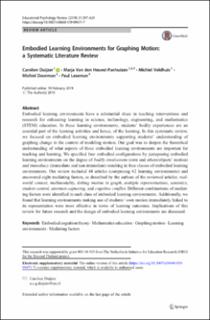| dc.contributor.author | Duijzer, Carolien | |
| dc.contributor.author | Van den Heuvel-Panhuizen, Marja | |
| dc.contributor.author | Veldhuis, Michiel | |
| dc.contributor.author | Doorman, Michiel | |
| dc.contributor.author | Leseman, Paul | |
| dc.date.accessioned | 2020-06-17T13:43:09Z | |
| dc.date.available | 2020-06-17T13:43:09Z | |
| dc.date.created | 2019-03-21T14:12:48Z | |
| dc.date.issued | 2019 | |
| dc.identifier.citation | Duijzer, C., Van den Heuvel-Panhuizen, M., Veldhuis, M., Doorman, M., Leseman, P. (2019). Embodied learning environments for graphing motion: a systematic literature review. Educational Psychology Review, 31, 597-629. doi: | en_US |
| dc.identifier.issn | 1573-336X | |
| dc.identifier.uri | https://hdl.handle.net/11250/2658517 | |
| dc.description.abstract | Embodied learning environments have a substantial share in teaching interventions and research for enhancing learning in science, technology, engineering, and mathematics (STEM) education. In these learning environments, students’ bodily experiences are an essential part of the learning activities and hence, of the learning. In this systematic review, we focused on embodied learning environments supporting students’ understanding of graphing change in the context of modeling motion. Our goal was to deepen the theoretical understanding of what aspects of these embodied learning environments are important for teaching and learning. We specified four embodied configurations by juxtaposing embodied learning environments on the degree of bodily involvement (own and others/objects’ motion) and immediacy (immediate and non-immediate) resulting in four classes of embodied learning environments. Our review included 44 articles (comprising 62 learning environments) and uncovered eight mediating factors, as described by the authors of the reviewed articles: real-world context, multimodality, linking motion to graph, multiple representations, semiotics, student control, attention capturing, and cognitive conflict. Different combinations of mediating factors were identified in each class of embodied learning environments. Additionally, we found that learning environments making use of students’ own motion immediately linked to its representation were most effective in terms of learning outcomes. Implications of this review for future research and the design of embodied learning environments are discussed. | en_US |
| dc.language.iso | eng | en_US |
| dc.publisher | Springer | en_US |
| dc.rights | Navngivelse 4.0 Internasjonal | * |
| dc.rights.uri | http://creativecommons.org/licenses/by/4.0/deed.no | * |
| dc.title | Embodied learning environments for graphing motion : a systematic literature review | en_US |
| dc.type | Peer reviewed | en_US |
| dc.type | Journal article | en_US |
| dc.description.version | publishedVersion | en_US |
| dc.rights.holder | © 2019 The Author(s) | en_US |
| dc.subject.nsi | VDP::Samfunnsvitenskap: 200::Pedagogiske fag: 280::Fagdidaktikk: 283 | en_US |
| dc.subject.nsi | VDP::Matematikk og Naturvitenskap: 400 | en_US |
| dc.subject.nsi | VDP::Teknologi: 500 | en_US |
| dc.source.pagenumber | 597-629 | en_US |
| dc.source.volume | 31 | en_US |
| dc.source.journal | Educational Psychology Review | en_US |
| dc.identifier.doi | 10.1007/s10648-019-09471-7 | |
| dc.identifier.cristin | 1686735 | |
| dc.description.localcode | Paid Open Access | en_US |

